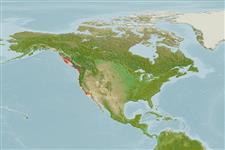>
Ovalentaria/misc (Various families in series Ovalentaria) >
Embiotocidae (Surfperches)
Etymology: Embiotoca: Greek, embios = permanent, for all the life + Greek, tokos,-oy = birth (Ref. 45335); lateralis: lateralis meaning lateral - referring to its blue stripes (Ref. 6885).
More on author: Agassiz.
Environment: milieu / climate zone / depth range / distribution range
Écologie
marin démersal; profondeur ? - 21 m (Ref. 2850). Subtropical; 58°N - 29°N, 138°W - 115°W
Eastern Pacific: Wrangell, southeastern Alaska to Point Cabras, northern Baja California, Mexico.
Taille / Poids / Âge
Maturity: Lm ? range ? - ? cm
Max length : 38.0 cm TL mâle / non sexé; (Ref. 2850); âge max. reporté: 10 années (Ref. 56049)
Épines dorsales (Total): 10 - 11; Rayons mous dorsaux (Total): 23-25; Épines anales 3; Rayons mous anaux: 29 - 33. Copper ground color with dark brown overlay on back; a series of about 15 blue horizontal stripes below lateral line; head with several series of blue spots and stripes; fins coppery; dark areas on anterior part of rayed dorsal, base of caudal fin, anterior part of anal, and distal halves of pelvic fins (Ref. 6885).
Adults occur in rocky coasts and kelp beds, occasionally in sandy surf near rocks (Ref. 2850). Feed on small crustaceans, worms, and mussels; occasionally on herring eggs (Ref. 4925). Viviparous, female carries the developing young (Ref. 205).
Life cycle and mating behavior
Maturité | Reproduction | Frai | Œufs | Fécondité | Larves
Viviparous, female carries the developing young (Ref. 205).
Eschmeyer, W.N., E.S. Herald and H. Hammann, 1983. A field guide to Pacific coast fishes of North America. Boston (MA, USA): Houghton Mifflin Company. xii+336 p. (Ref. 2850)
Statut dans la liste rouge de l'IUCN (Ref. 130435)
Menace pour l'homme
Harmless
Utilisations par l'homme
Pêcheries: commercial; pêche sportive: oui; Aquarium: Aquariums publics
Plus d'informations
RéférencesAquacultureProfil d'aquacultureSouchesGénétiqueElectrophoresesHéritabilitéPathologiesTraitementNutrientsMass conversion
Outils
Articles particuliers
Télécharger en XML
Sources Internet
Estimates based on models
Preferred temperature (Ref.
123201): 9.3 - 15.4, mean 10.7 °C (based on 149 cells).
Phylogenetic diversity index (Ref.
82804): PD
50 = 0.7500 [Uniqueness, from 0.5 = low to 2.0 = high].
Bayesian length-weight: a=0.01905 (0.00831 - 0.04372), b=2.97 (2.77 - 3.17), in cm total length, based on LWR estimates for this (Sub)family-body shape (Ref.
93245).
Niveau trophique (Ref.
69278): 3.3 ±0.49 se; based on food items.
Résilience (Ref.
120179): Milieu, temps minimum de doublement de population : 1,4 à 4,4 années (tm=3; tmax=10).
Fishing Vulnerability (Ref.
59153): Low to moderate vulnerability (28 of 100).
Nutrients (Ref.
124155): Calcium = 87.1 [48.9, 153.1] mg/100g; Iron = 1.03 [0.60, 1.78] mg/100g; Protein = 18.6 [17.6, 19.6] %; Omega3 = 0.234 [0.144, 0.385] g/100g; Selenium = 20.3 [9.9, 41.2] μg/100g; VitaminA = 9.67 [2.94, 31.27] μg/100g; Zinc = 0.75 [0.53, 1.11] mg/100g (wet weight);
